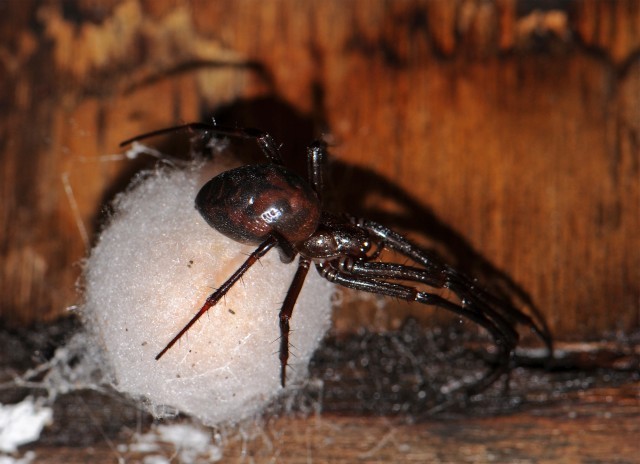When it comes to spiders in the UK, the cave spider is one of the most fascinating yet misunderstood species. Found in dark, damp environments such as caves, tunnels, and cellars, these spiders are often mistaken for more dangerous species due to their size and appearance. However, cave spiders in the UK are generally harmless to humans and play an important role in the ecosystem by controlling insect populations.
Whether you’re a wildlife enthusiast, a homeowner dealing with spiders, or simply curious about UK arachnids, understanding cave spiders can help you identify them and appreciate their role in nature. This guide will cover everything you need to know about cave spiders in the UK, including their appearance, habitat, behaviour, and how to distinguish them from other spider species.
Understanding Cave Spiders in the UK
Cave spiders belong to the Meta genus, with the two most common species in the UK being:
- Meta menardi (the large cave spider)
- Meta bourneti (the lesser cave spider)
These spiders are well-adapted to dark, humid environments and are often found in caves, abandoned mines, and even man-made structures like basements and tunnels. Unlike house spiders, cave spiders rarely venture into homes, preferring undisturbed, damp locations.
How to Identify a Cave Spider UK
Cave spiders have distinct features that set them apart from other UK spiders:
- Size: Large cave spiders (Meta menardi) can have a leg span of up to 7cm, while lesser cave spiders (Meta bourneti) are slightly smaller.
- Colour: Typically dark brown or reddish-brown with a glossy appearance.
- Body Shape: Oval abdomen with long, slender legs.
- Webs: Unlike orb-weaving spiders, cave spiders spin irregular, sheet-like webs in dark corners.
If you spot a large, dark spider in a cave-like environment, it’s likely a cave spider rather than a more common house spider.
Where Are Cave Spiders Found in the UK?
Cave spiders thrive in cool, damp, and dark locations. Some of their most common habitats include:
- Natural caves (especially in limestone regions)
- Old mines and tunnels
- Cellars and basements
- Drainage systems and wells
These spiders are widespread across the UK but are more commonly found in areas with suitable underground habitats, such as the Peak District, Yorkshire Dales, and parts of Wales.
Are Cave Spiders Dangerous?
Despite their intimidating size, cave spiders in the UK are not dangerous to humans. They are non-aggressive and rarely bite unless provoked. Their venom is weak and not medically significant, posing no threat to people.
If you encounter a cave spider, it’s best to leave it undisturbed, as they play a crucial role in controlling pests like flies and other small insects.
How to Distinguish Cave Spiders from Other UK Spiders
Several large spiders in the UK are often confused with cave spiders. Here’s how to tell them apart:
1. Cave Spider vs. Giant House Spider
- Giant house spiders are faster, hairier, and commonly found indoors.
- Cave spiders prefer dark, damp environments and have a shinier appearance.
2. Cave Spider vs. False Widow Spider
- False widows have a bulbous, round abdomen and a darker, more matte colour.
- Cave spiders are smoother and less likely to be found in homes.
3. Cave Spider vs. Cardinal Spider
- Cardinal spiders are much larger (up to 12cm leg span) and often found in old buildings.
- Cave spiders are smaller and restricted to dark, humid areas.
What to Do If You Find a Cave Spider
If you discover a cave spider in your basement or cellar:
- Do not kill it – They are harmless and beneficial.
- Relocate it carefully (if necessary) using a jar and a piece of paper.
- Seal entry points to prevent more from entering (though they rarely infest homes).
Conclusion: The Role of Cave Spiders in the UK
Cave spiders are an important part of the UK’s ecosystem, helping to keep insect populations in check. While their size may be alarming to some, they pose no real threat to humans. By understanding their habitat and behaviour, we can coexist with these fascinating creatures and appreciate their role in nature.
Frequently Asked Questions (FAQs)
Are cave spiders in the UK venomous?
Yes, but their venom is very weak and not harmful to humans.
How big do UK cave spiders get?
The largest species (Meta menardi) can have a leg span of up to 7cm.
Do cave spiders live in houses?
Rarely. They prefer caves, tunnels, and cellars rather than living spaces.
What do cave spiders eat?
They feed on small insects like flies, moths, and other arthropods.
How long do cave spiders live?
They can live for several years, much longer than many other spider species.
Should I be worried if I find a cave spider?
No, they are harmless and should be left alone or relocated if necessary.
Where in the UK are cave spiders most common?
They are often found in limestone caves in regions like the Peak District and Yorkshire.
By learning more about cave spiders in the UK, we can reduce unnecessary fear and appreciate these unique arachnids for their ecological benefits.
You may also read: Audi Aberdeen – New & Approved Used Cars | John Clark Dealer




